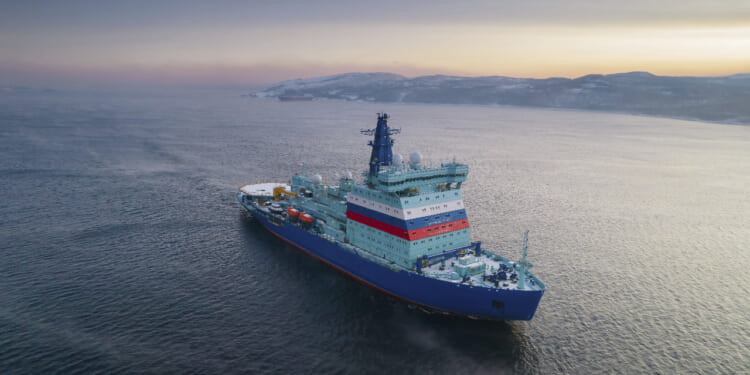The need to regulate nuclear-powered ships is a matter that will only grow more pressing with the passage of time.
After decades in which the world’s only nuclear-powered merchant ship, the NS Savannah, sat quietly as a museum exhibit in Baltimore, the notion of atomic propulsion for commercial seagoing vessels is steaming back into view. Shipping companies, who are facing steep decarbonization targets, are the latest industry to revisit nuclear power’s allure, with its immense energy density, zero greenhouse gas emissions at the point of use, and round-the-world endurance without bunkering. Especially for long-haul commercial shipping that takes consistent routes, including the Asia-US Pacific trade routes, what once seemed a Cold War curiosity is being recast as a potential workhorse of a carbon-constrained up-and-coming century.
What makes this consideration timely is not nostalgia but economics and technological innovation, including new reactor designs and production processes. In October 2025, the classification society DNV published a white paper concluding that nuclear propulsion could become a “viable” route to deep emissions cuts if reactor designs are modularized and costs are driven down by series production. The International Atomic Energy Agency (IAEA) has also shown renewed interest in the concept. Its new ATLAS initiative is engaging Greece, the world’s largest ship-owning nation, to sketch a global safety and oversight framework. Meanwhile, Russia continues to operate the only existing civilian nuclear fleet in the form of its icebreakers that are working the Northern Sea Route, offering proof of concept, if not a model for governance.
The development of a workable international regulatory framework will be among the vital elements required for this revival to take hold.
The current international legal foundation for nuclear-powered commercial shipping lies in the International Convention for the Safety of Life at Sea (SOLAS), which, since 1974, has contained a special chapter on nuclear powered ships. Chapter VIII of SOLAS sets high-level safety obligations and incorporates by reference the subsequent International Maritime Organization (IMO) 1981 Code of Safety for Nuclear Merchant Ships, a detailed design and operations guide written with 1970s pressurized-water technology in mind. That code remains extant but dated. The IMO recently agreed to revise it, under industry pressure, to cover inter alia advanced reactor designs.
International law currently adds two further principled planks to this framework. First, under the 1982 United Nations Convention on the Law of the Sea (UNCLOS), a ship on the high seas falls under the exclusive jurisdiction of its national flag state, which, pursuant to Article 94, must exercise “effective control” over safety and technical matters on board the vessel. Second, coastal states retain the right to regulate entry into their ports and territorial seas. While foreign nuclear-powered ships enjoy a presumptive right of innocent passage through the territorial sea, in its Article 23, UNCLOS requires them to carry specific documentation and comply with “special precautionary measures” set out in international agreements. Coastal states can use this principle to condition port entry and impose additional safety requirements.
From a domestic regulatory perspective, the governance challenges for nuclear-powered commercial vessels resemble those posed by land-based novel and advanced reactors, including small modular reactors (SMRs) and microreactors (MRs). These challenges include the licensing of novel designs, demonstrating passive safety, qualifying fuels, securing supply chains, managing waste and decommissioning, and ensuring third-party liability. Yet, nuclear propulsion at sea adds several distinct complications, most of which center around the mobility of the reactors and fuel.
A reactor that moves across jurisdictions onboard a seagoing vessel raises several challenges to existing legal regimes, both international and national, that stationary reactors do not. These include trade regulation, safeguards, materials security, and related nonproliferation concerns.
Transfers or movements of reactor hardware, fuel, instrumentation, and software among shipyards, flags, operators, and jurisdictions will often trigger supplier-state controls under Nuclear Suppliers Group (NSG) guidelines and domestic regulation. Amendment of the NSG’s guidelines, which can then trickle down into states’ domestic export control rules, will likely be necessary to accommodate this new mobile use of commercial reactors.
Under Comprehensive Safeguards Agreements between states and the IAEA, safeguards must extend to nuclear material and facilities wherever they are, and this will make the monitoring and enforcement of safeguards on constantly moving reactors challenging to say the least. This is a thorny problem that will need to be resolved on a bilateral basis between states and the IAEA. Similar concerns have been raised in the context of Australia’s planned AUKUS submarines.
International and domestic law regulating materials security is another related concern. Existing treaties were, of course, designed for fixed installations or for discrete shipments of nuclear fuel, and not for reactors that sail across jurisdictions. Physical protection is primarily addressed by the Convention on the Physical Protection of Nuclear Material (CPPNM) and its 2005 Amendment, which oblige states to protect nuclear material in use, storage, and international transport. IAEA guidance document INFCIRC/225/Rev.5 elaborates graded requirements for such protection. These standards could extend to shipboard reactors, but neither the CPPNM nor INFCIRC 225 contemplates a reactor that is simultaneously a means of propulsion and a moving source term. To accommodate nuclear propulsion in merchant fleets, this and related treaty regimes will need careful adaptation.
All of these treaties and the implementation of domestic legal regimes, of course, have as their raison d’être the protection of humans and the environment from the harmful effects of radiation, as well as nonproliferation concerns that focus on the prevention of diversion of nuclear material and related technologies away from peaceful commercial purposes and toward weapons development programs.
Again, international law grants the flag state of a vessel primary regulatory and enforcement jurisdiction. In practice, many open registries that dominate commercial shipping — e.g. Panama, Liberia, and the Marshall Islands — lack deep nuclear-regulatory capacity. This poses a further challenge to the implementation of adapted legal regulations. And even with flag-state implementation, coastal and port states have the legal right to deny entry or impose special conditions.
All of this, which is only a representative list of the challenges to existing law posed by nuclear propulsion of commercial vessels, is not to say that adapting the law to nuclear powered shipping is impossible. Far from it. Squarer pegs have been fitted into rounder holes in the past. But it will take a concerted and coordinated effort, including nuclear materials and technology supply countries, frequent port destination countries and coastal states, and shipping and nuclear industry representatives, to make the necessary revisions to international and domestic law in order to facilitate this novel use of nuclear energy.
But the means here are justified by the potential ends. The potential for zero-carbon propulsion across long-haul shipping routes could sharply reduce reliance on bunker fuels — i.e., heavy residual oils burned by most ocean-going ships — and accordingly cut greenhouse gas emissions and volatile fuel price exposure. The shipping industry consumes roughly 350 million tons of fossil fuel annually and accounts for about three percent of total worldwide carbon emissions.
If the world’s largest container and bulk-carrier routes adopted even a modest fleet of nuclear-powered ships, the cumulative fuel savings over a 20-year operational life would easily justify the investment in regulatory design, enabling both infrastructural and supply-chain certainty. The legal scaffolding necessary to facilitate this transition should be built now, as the environmental and commercial benefits are both real and urgent.
About the Author: Daniel Joyner
Daniel Joyner is the Elton B. Stephens Professor of Law at the University of Alabama School of Law, and the Founder and Principal at Prometheus Nuclear LLC. Prior to joining the Alabama Law faculty in 2007, Professor Joyner taught for four years on the faculty of the University of Warwick School of Law. He is the author of ‘International Law and the Proliferation of Weapons of Mass Destruction‘ (Oxford University Press, 2009); ‘Interpreting the Nuclear Nonproliferation Treaty‘ (Oxford University Press, 2011); and ‘Iran’s Nuclear Program and International Law‘ (Oxford University Press, 2016).
Image: Shutterstock/maks_ph


















